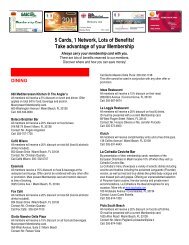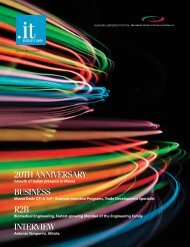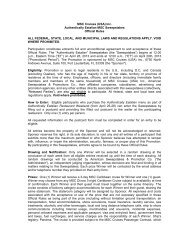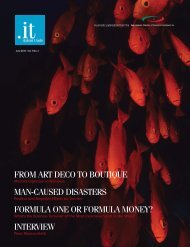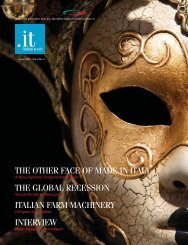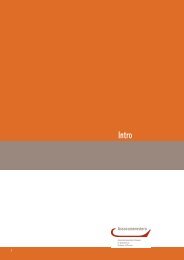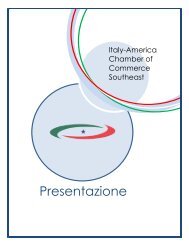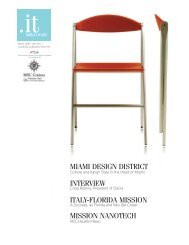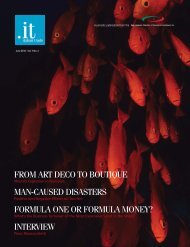italian fashion defines luxury - Italy-America Chamber of Commerce ...
italian fashion defines luxury - Italy-America Chamber of Commerce ...
italian fashion defines luxury - Italy-America Chamber of Commerce ...
Create successful ePaper yourself
Turn your PDF publications into a flip-book with our unique Google optimized e-Paper software.
R2B<br />
A Creative Mind at Work<br />
has the potential to have an impact on the world we know today by <strong>of</strong>fering a<br />
sustainable solution to the current energy problem.<br />
The renewable energy solutions we know today are better than conventional<br />
ones, but are not as good as we need them to be. Some are dependent on<br />
location (hydro, tidal and geothermal), some are potentially polluting (biomass),<br />
and others may not give enough electricity against investment (solar and ro<strong>of</strong>top<br />
windmills). All solutions require high investment, much maintenance and are<br />
not efficient enough to sustain our electricity need. For example, wind turbines<br />
in the South-East cannot efficiently generate energy because the average wind<br />
speed is about 8 mph and turbines require an input flow above this level. As<br />
a remedy, tower turbines are placed 60 miles <strong>of</strong>f the coast resulting in a costly<br />
alternative for maintenance and the miles <strong>of</strong> cable needed to transport energy<br />
to shore. Similarly, ro<strong>of</strong>-top wind mills are no option at all in these states. The<br />
Ro<strong>of</strong> Wind Energy System <strong>of</strong>fers a novel solution by increasing the wind velocity<br />
with funnels, in a way that electricity can be efficiently generated. This makes<br />
wind energy a good solution for South-Eastern states and an even better one for<br />
regions with stronger winds.<br />
The Ro<strong>of</strong> Wind Energy System is based on a simple physical phenomenon<br />
together with a ro<strong>of</strong> design integration <strong>of</strong> funnels, turbine and structure. When<br />
a flow <strong>of</strong> air enters a funnel with a skewed shape, its velocity has to increase<br />
locally in order to stay in balance with the overall flow on a greater scale. This<br />
phenomenon is called the Venturi Effect and is experienced by the accelerating<br />
winds between buildings for example. A ro<strong>of</strong> system, or a portion <strong>of</strong> it, may be<br />
partitioned in funnels which also have the function <strong>of</strong> stiff structural elements,<br />
like Roman bows. These funnels capture and lead the air flow (see Fig. 1) and,<br />
since they are three-dimensionally skewed towards the ro<strong>of</strong> top (see Fig. 2), they<br />
create the highest velocity at this final section. The air flow velocity can easily<br />
increase five times after taking all the physical factors into account. A vertical-axle<br />
turbine is placed at the ro<strong>of</strong> top so that the highest possible amount <strong>of</strong> energy<br />
can be generated at the point <strong>of</strong> highest velocity.<br />
Two additional mechanisms improve the efficiency <strong>of</strong> the system. Firstly, on the<br />
lee-ward side, the flow going over the ro<strong>of</strong> (see Fig. 1) creates a lower backpressure<br />
at the exit <strong>of</strong> the funnel. This creates suction at the exit which further<br />
increases the acceleration <strong>of</strong> the flow. The level <strong>of</strong> suction obviously depends<br />
on the shape <strong>of</strong> the ro<strong>of</strong>. Secondly, on the wind-ward side, the wind hitting the<br />
façade under the ro<strong>of</strong>, cannot go anywhere but upwards and can be captured<br />
by opened louvers at the entrance <strong>of</strong> the funnels which direct this great volume<br />
<strong>of</strong> air into the funnel towards the generator. Together, a large skewed volume,<br />
suction from the back and an additional volume from the façade, contribute to<br />
generate a higher amount <strong>of</strong> wind energy electricity compared to systems on the<br />
market today.<br />
Le odierne forme di energia rinnovabile sono certo alternative<br />
migliori rispetto a quelle tradizionali, ma non tanto quanto ce<br />
ne sarebbe bisogno. Alcune sono dipendenti dalla localizzazione<br />
(idrica, geotermale, di marea), altre sono potenzialemente<br />
inquinanti (biomasse), altre ancora potrebbero non creare<br />
sufficiente elettricità da ripagare gli investimenti iniziali (solare ed<br />
eolico). Ognuna di queste soluzioni richiede investimenti onerosi,<br />
una continua manutenzione ed in generale non sono abbastanza<br />
efficienti da supplire ai nostri bisogni di approvviggionamento<br />
elettrico. Per esempio, le turbine eoliche del sud-est non riescono<br />
a generare efficientemente energia poiché la velocità media dei<br />
venti, non superiore alle otto miglia all’ora, é troppo bassa rispetto<br />
a quella necessaria per un ottimale funzionamento del sistema. Per<br />
ovviare a questo, i piloni sono stati posizionati a sessanta miglia a<br />
largo della costa, rendendo peró piú costosa sia la manutenzione<br />
che il trasporto dell’energia fino alla terraferma, a causa della<br />
maggiore lunghezza dei cavi elettrici. Allo stesso modo, le turbine<br />
eoliche non rappresentano un’opzione valida in questi stessi stati.<br />
Il “Ro<strong>of</strong> Wind Energy System”, invece, inquadra una soluzione<br />
innovativa che sfrutta la maggiore velocitá dei flussi ventosi<br />
provocata dall’utilizzo di strutture ad imbuto, cosí consentendo<br />
un’efficiente generazione di energia. Questo fa dell’eolico una<br />
buona soluzione per le necessità energetiche degli stati del sud-est,<br />
ed ancora migliore per le regioni caratterizzate da venti piú forti.<br />
Il funzionamento del “Ro<strong>of</strong> Wind Energy System” si basa su<br />
un semplice fenomeno fisico associato all’utilizzo di un tetto<br />
dal design integrato tra sistemi ad imbuto, turbina e struttura.<br />
Quando il flusso d’aria entra in un imbuto dal pr<strong>of</strong>ilo inclinato,<br />
la sua velocità aumenta localmente al fine di mantenere un<br />
equilibrio rispetto all’andamento generale del flusso stesso. Questo<br />
fenomeno, noto come Effetto Venturi, è, per esempio, lo stesso<br />
che causa l’accelerazione dei venti che s<strong>of</strong>fiano tra gli edifici nei<br />
centri urbani. Un tetto dunque, o una porzione di esso, potrebbe<br />
essere ripartito in sistemi ad imbuto che abbiano anche la funzione<br />
di elementi strutturali portanti, come l’arco romano. A causa della<br />
loro inclinazione tridimensionale, questi tetti-imbuto catturano<br />
l’aria e ne indirizzano i flussi verso la sommitá del tetto, dove questi<br />
raggiungono la loro massima velocitá. Considerati i diversi fattori<br />
fisicamente rilevanti, la velocità dell’aria può essere facilmente<br />
incrementata di ben cinque volte. Una turbina sul suo asse verticale<br />
é pertanto posizionata sulla sommitá tetto, in modo da catturare<br />
la maggiore quantità possibile di energia nel punto di massima<br />
velocità dei flussi ventosi.<br />
Esistono altri due meccanismi che permettono un miglioramento<br />
dell’efficienza del sistema. Considerato il lato sotto vento, le<br />
correnti sul tetto generano una minore contropressione all’uscita<br />
dall’imbuto. Ció crea un effetto aspirante subito all’esterno<br />
dell’imbuto che incrementa ulteriormente la velocitá del flusso<br />
d’aria. Il livello di aspirazione chiaramente dipende dalla sagoma del<br />
tetto. Considerato invece il lato sopravento, la corrente che colpisce<br />
la parte frontale sotto il tetto è costretta verso l’alto e catturata<br />
da feritoie aperte all’imbocco dell’imbuto che ne dirigono il suo<br />
grande volume all’interno dell’imbuto in direzione del generatore.<br />
Messi nsieme, un grosso volume inclinato, l’aspirazione dal retro<br />
e il volume addizionale proveniente dal fronte, contribuiscono<br />
alla creazione di una quantitá di energia eolica più alta rispetto ai<br />
sistemi oggi presenti sul mercato.<br />
Other advantages are that the turbine is now integrated with the ro<strong>of</strong> therefore,<br />
noise and unpleasant aesthetics are being resolved and a sustainable structural<br />
design with a better insulated ro<strong>of</strong> further reduces the need for energy. Modeling<br />
indicates that the proposed ro<strong>of</strong> design for a standard single-family household<br />
in the State <strong>of</strong> Florida would <strong>of</strong>fer more electricity than needed. The initial<br />
.32



